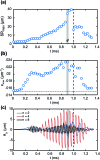Shape oscillations of particle-coated bubbles and directional particle expulsion
- PMID: 27714376
- PMCID: PMC5304335
- DOI: 10.1039/c6sm01603k
Shape oscillations of particle-coated bubbles and directional particle expulsion
Abstract
Bubbles stabilised by colloidal particles can find applications in advanced materials, catalysis and drug delivery. For applications in controlled release, it is desirable to remove the particles from the interface in a programmable fashion. We have previously shown that ultrasound waves excite volumetric oscillations of particle-coated bubbles, resulting in precisely timed particle expulsion due to interface compression on a ultrafast timescale [Poulichet et al., Proc. Natl. Acad. Sci. U. S. A., 2015, 112, 5932]. We also observed shape oscillations, which were found to drive directional particle expulsion from the antinodes of the non-spherical deformation. In this paper we investigate the mechanisms leading to directional particle expulsion during shape oscillations of particle-coated bubbles driven by ultrasound at 40 kHz. We perform high-speed visualisation of the interface shape and of the particle distribution during ultrafast deformation at a rate of up to 104 s-1. The mode of shape oscillations is found to not depend on the bubble size, in contrast with what has been reported for uncoated bubbles. A decomposition of the non-spherical shape in spatial Fourier modes reveals that the interplay of different modes determines the locations of particle expulsion. The n-fold symmetry of the dominant mode does not always lead to desorption from all 2n antinodes, but only those where there is favourable alignment with the sub-dominant modes. Desorption from the antinodes of the shape oscillations is due to different, concurrent mechanisms. The radial acceleration of the interface at the antinodes can be up to 105-106 ms-2, hence there is a contribution from the inertia of the particles localised at the antinodes. In addition, we found that particles migrate to the antinodes of the shape oscillation, thereby enhancing the contribution from the surface pressure in the monolayer.
Figures






References
-
- Aveyard R., Binks B. P., Clint J. H. Adv. Colloid Interface Sci. 2003;100–102:503–546.
-
- Binks B. P., Horozov T. S. Angew. Chem., Int. Ed. 2005;44:3722–3725. - PubMed
-
- Binks B. P. Curr. Opin. Colloid Interface Sci. 2002;7:21–41.
-
- Dinsmore A. D., Hsu M. F., Nikolaides M. G., Marquez M., Bausch A. R., Weitz D. A. Science. 2002;298:1006–1009. - PubMed
-
- Kam S. I., Rossen W. R. J. Colloid Interface Sci. 1999;213:329–339. - PubMed
LinkOut - more resources
Full Text Sources
Other Literature Sources

